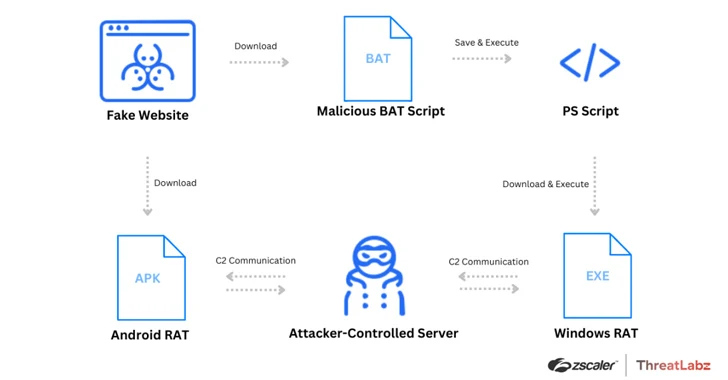Threat actors have been leveraging fake websites advertising popular video conferencing software such as Google Meet, Skype, and Zoom to deliver a variety of malware targeting both Android and Windows users since December 2023.
“The threat actor is distributing Remote Access Trojans (RATs) including SpyNote RAT for Android platforms, and NjRAT and DCRat for Windows systems,” Zscaler ThreatLabz researchers said.
The spoofed sites are in Russian and are hosted on domains that closely resemble their legitimate counterparts, indicating that the attackers are using typosquatting tricks to lure prospective victims into downloading the malware.
They also come with options to download the app for Android, iOS, and Windows platforms. While clicking on the button for Android downloads an APK file, clicking on the Windows app button triggers the download of a batch script.
The malicious batch script is responsible for executing a PowerShell script, which, in turn, downloads and executes the remote access trojan.
Currently, there is no evidence that the threat actor is targeting iOS users, given that clicking on the button for the iOS app takes the user to the legitimate Apple App Store listing for Skype.
“A threat actor is using these lures to distribute RATs for Android and Windows, which can steal confidential information, log keystrokes, and steal files,” the researchers said.
The development comes as the AhnLab Security Intelligence Center (ASEC) revealed that a new malware dubbed WogRAT targeting both Windows and Linux is abusing a free online notepad platform called aNotepad as a covert vector for hosting and retrieving malicious code.
It’s said to be active from at least late 2022, targeting Asian countries like China, Hong Kong, Japan, and Singapore, among others. That said, it’s currently not known how the malware is distributed in the wild.
“When WogRAT is run for the first time, it collects basic information of the infected system and sends them to the C&C server,” ASEC said. “The malware then supports commands such as executing commands, sending results, downloading files, and uploading these files.”
It also coincides with high-volume phishing campaigns orchestrated by a financially motivated cybercriminal actor known as TA4903 to steal corporate credentials and likely follow them with business email compromise (BEC) attacks. The adversary has been active since at least 2019, with the activities intensifying post mid-2023.
“TA4903 routinely conducts campaigns spoofing various U.S. government entities to steal corporate credentials,” Proofpoint said. “The actor also spoofs organizations in various sectors including construction, finance, healthcare, food and beverage, and others.”
Attack chains involve the use of QR codes (aka quishing) for credential phishing as well as relying on the EvilProxy adversary-in-the-middle (AiTM) phishing kit to bypass two-factor authentication (2FA) protections.
Once a target mailbox is compromised, the threat actor has been observed searching for information relevant to payments, invoices, and bank information, with the ultimate goal of hijacking existing email threads and performing invoice fraud.
Phishing campaigns have also functioned as a conduit for other malware families like DarkGate, Agent Tesla, and Remcos RAT, the last of which leverages steganographic decoys to drop the malware on compromised hosts.












